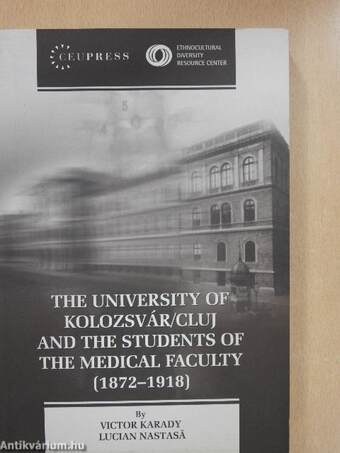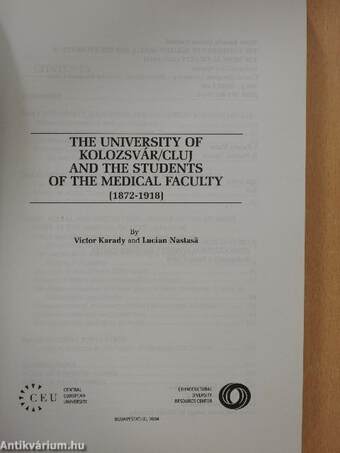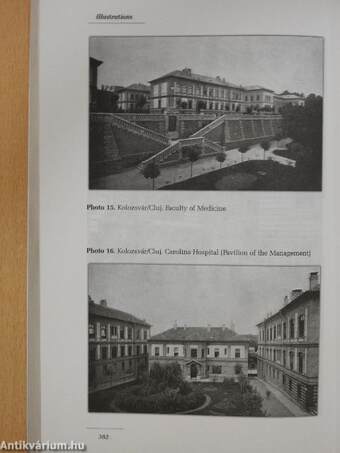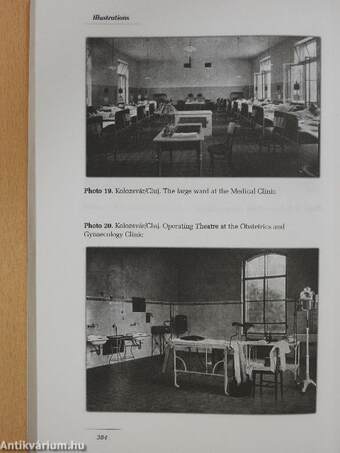1.067.715
kiadvánnyal nyújtjuk Magyarország legnagyobb antikvár könyv-kínálatát

VISSZA
A TETEJÉRE
JAVASLATOKÉszre-
vételek
The University of Kolozsvár/Cluj and the Students of the Medical Faculty
(1872-1918)
| Kiadó: | Central European University-Ethnocultural Diversity Resource Center |
|---|---|
| Kiadás helye: | Budapest-Kolozsvár |
| Kiadás éve: | |
| Kötés típusa: | Ragasztott papírkötés |
| Oldalszám: | 392 oldal |
| Sorozatcím: | |
| Kötetszám: | |
| Nyelv: | Angol |
| Méret: | 24 cm x 16 cm |
| ISBN: | 973-86239-3-6 |
| Megjegyzés: | Néhány fekete-fehér fotókkal. |
naponta értesítjük a beérkező friss
kiadványokról
naponta értesítjük a beérkező friss
kiadványokról
Előszó
FOREWORD
With this volume the authors initiate a hopefully large set of publica-tions intended to contribute to the acceleration of a rather new development in the study of modern and... Tovább
Előszó
FOREWORD
With this volume the authors initiate a hopefully large set of publica-tions intended to contribute to the acceleration of a rather new development in the study of modern and modernising elite groups in the Carpathian Basin during the long nineteenth century.
This was, as it is well known, the period of nation building in East Central Europe, where various national projects elaborated by regionally based elite groups, endowed with historically accumulated but very unequal political, economic, intellectual and symbolic assets, converged or collided in the Magyar nation state emerging after the 1867 Compromise with Austria. The study of these elite groups appears to be crucial for the understanding of all major social processes leading to the 1919 disruption, including such differ-ent ones as industrialisation, urbanisation, the creation of parliamentary statehood and contemporary patterns of political mobilisation, the establish-ment of the intellectual infrastructure of modern societies (the press, the school network, agencies of cultural production), the evolution of ethnic power relations (as expressed in national antagonism, antisemitism, assimi-lation), new models of class identity together with their expressions and con-flicts (for example, embourgeoisement versus gentrification), modern demo-graphic structures, etc. In one way or another elites were responsible for the invention, the realisation or the imposition of often contrasted or even antag-onistic patterns of modernity in this part of Europe, explicable only via their recruitment (by ethnicity, religion, properties, noble or plebeian birth), inher-ited 'social capital', aggregate interests, strategies of self-assertion, represen-tations of collective future as well as the utopias and salvation ideologies they adopted (whether liberal, socialist, free masonic or other) or the claims they extended for leadership in 'imagined communities'.
Hitherto the study of elites remained largely fragmented by fields of activities (the economy, politics, administration, academe, literature, the arts, etc). In the last decades West European social history has produced somé precious research on top elite segments and even larger, institutional-ly defined elite clusters - like alumni of outstandingly prestigious educa-tional institutions. This scholarly orientation draws heavily on historical sta-tistics, occasionally produced by national statistical agencies, and local prosopographies, listing members of selected institutions. Recently the tech-nological revolution of computer science has opened new vistas in elite studies. A number of biographical data banks have been published on what Vissza
Tartalom
CONTENTS
FOREWORD 7
Part I. UNIVERSITY EDUCATION AND CULTURE IN KOLOZSVÁR/CLUJ
Historical precedents and preliminaries 15
Towards the foundation of the modern Transylvanian University 21
The beginnings of the new University 29
Kolozsvár/Cluj as a mature academic centre of
the late Duálist Period 37
Part II. MEDICAL HIGHER EDUCATION IN KOLOZSVÁR/CLUJ
The beginnings of medical instruction 49
Medicine at the "Franz Josef" University 52
Epilogue of the Hungárián Medical School 68
Part III. SOCIAL AND EDUCATIONAL PROFILÉ OF THE STUDENT BODY AT THE MEDICAL FACULTY (1872-1918)
Social and eductional profilé of the student body at
the medical faculty (1872-1918) 71
The medics from Kolozsvár/Cluj and the training of
doctors in Hungary 73
The logic of recruitment differentials 83
Patterns of ethnic and confessional recruitment 91
Paradigms of régiónál selection: place of birth, residence, locality of
Matura-granting schools 99
Circumstances of secondary studies ('educational selection') 109
Social structure and social selection 125
Tuition and the conditions of study 135
Part IV. STUDENT POPULATION
Listing of students at the Faculty of Medicine (1872-1918) 151
ILLUSTRATIONS 369
INDEX OF PERSONS' NAMES 389
INDEX OF PLACE NAMES 392
Témakörök
- Idegennyelv > Idegennyelvű könyvek > Angol > Orvostudomány
- Idegennyelv > Idegennyelvű könyvek > Angol > Művelődéstörténet
- Idegennyelv > Idegennyelvű könyvek > Angol > Helytörténet
- Idegennyelv > Idegennyelvű könyvek > Angol > Pedagógia
- Művelődéstörténet > Intézményei > Iskolák
- Pedagógia > Intézmények > Oktatási intézmények > Felsőoktatás > Egyetem
- Pedagógia > Pedagógia történet > Tanulmányok
- Helytörténet > Helyismeret > Intézmények
- Orvostudomány > Általános orvosi, egyéb > Egészségügy > Intézmények > Egyetemek
- Orvostudomány > Általános orvosi, egyéb > Idegennyelvű
- Orvostudomány > Általános orvosi, egyéb > Orvostudomány története
- Orvostudomány > Orvosi idegennyelvű könyvek > Általános orvosi
- Szociológia > Szakszociológiák
- Szociológia > Tanulmányok, esszék
- Idegennyelv > Idegennyelvű könyvek > Angol > Szociológia > Szakszociológiák
- Idegennyelv > Idegennyelvű könyvek > Angol > Szociológia > Tanulmányok, esszék

















